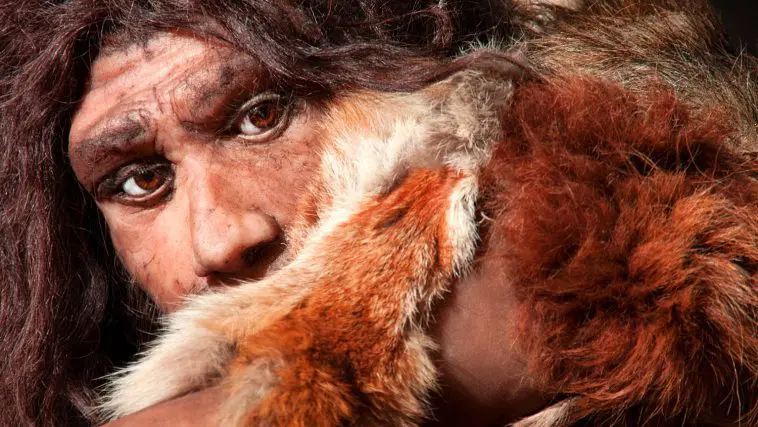[Originally published as the third part of 5 Reasons Why Neanderthals Were Simply Humans]
2. Evidence of Religious Activity
This point is very similar to the above and won’t require much expansion, but there is almost no question that Neanderthals practiced, in some measure, religion. In fact, Klein has argued that
“Neanderthal graves present the best case for Neanderthal spirituality or religion.”
Ruth Schuster, writing for the Israeli newspaper Haaretz, points out in a 2016 article:
The latest discovery suggesting that Neanderthals were not beetle-browed brutes is the seemingly intentional burial of a child about 40,000 years ago, in a cave some 100 kilometers from Madrid. The burial site of the so-called Loyoza Child was surrounded by hearths, in each of which the archaeologists found bones, antlers and nearby, one rhino skull. The child itself had been two to three years old and seems to have had its body burned. The team feels the fires could have been ceremonial rather than functional.1
Barbara King, a former anthology professor for the College of William and Mary (and an evolutionist), writes:
“Religion is best understood across cultures and time periods as practice rather than only belief. Some religions, of course, feature sacred texts in which a set of beliefs is set forth. In these cases, what you believe about a god or other sacred forces may really matter. In many human societies past and present, though, no text exists, just everyday life — appeasing gods or spirits, honoring the ancestors — that is shot through with a sense of the sacred or the supernatural. It’s within this context that the case for Neanderthal religion — for ritual practices steeped in connecting to the sacred world — is most convincingly made.”
While many are (rightly) skeptical of drawing such inferences from the available data, this one is certainly probable and reasonable according to the vast majority of evolutionary and creationist anthropologists.
3. Evidence of Tool-Making
Here is another example of data that evolutionists have capitalized on, while unsuspecting Christians (who have not carefully studied their Bible) have neglected information God has already given. Such is the error of those who approach the Bible as if it has only spiritual things to tell us, sadly neglecting the careful historical recording that has taken place.
On conventional dating, we first begin to see evidence of stone tool-making around 2.6 million years ago. These include hammer stones, stone cores, and sharp stone flakes. By all evolutionary accounts, these tools predate the arrival of humans.
This presents a problem for understanding the Neanderthal relationship to modern humans on old age views of the Bible.
If tools are showing up in the fossil record long before there were humans to make them, there is an obvious problem with the paradigm. The only hope of reconciliation is to relegate the Neanderthal to the level of “soul-less hominid,” but this has to be assumed despite the vast evidence that shows them to be fully human.
Of course, many think that this discovery poses a problem for young-age creationists. However, nothing could be further from the truth! Remember — on the young age view, we’re only a little over 6,000 years removed from Creation Week. Since we don’t accept conventional dating, it’s reasonable that we consult the source of our historical data — the Bible — to see where these stone tools fit in.
Earlier we referenced the Flood of Noah’s day (and the widespread devastation) and the Tower of Babel, which followed. The dispersion at Babel not only would result in cave dwelling behavior but also stone tool making as these isolated and bereft people groups came into their own, and only slowly were in a position to build more sophisticated structures, craft more useful tools, etc.
We would expect such first tools to be basic and primitive, improving with time as skills were developed. This is exactly what we find. We would also expect to find similar tools in different locales since members of different people groups would need to accomplish similar tasks in their respective locations.
Kurt Wise helps differentiate how these tools are understood between evolutionary and young-age creation models:
The most ancient cultural evidences of these activities are interpreted very differently in young-age creationism than any alternative model of earth history. A particular quality of stone tool, for example, is traditionally interpreted as indicating a particular period of earth history, as if that specific tool was made only at one time in earth history. In young-age creationism, however, the same potential for cultural evolution was possessed by numerous, closely related families at many different places across the earth. It is very likely that the same type of stone tool was developed independently by many different Babel families at many different locations on earth. At each location it was probably developed at a different time and was produced for a much briefer period than is thought in other theories.
Once again, we find that there is no necessary inference from this evidence. One might want to assume an evolutionary timeline and infer that evidence of tool-making supports it, but this evidence has a happy home on the young-age creationist view. Ironically, the most difficult views to cope with this evidence are those that aim to cohere conventional dating with biblical data.
Such a view cannot appeal to the global flood (nor the devastation that resulted),2 and as already mentioned, it necessitates that Neanderthals were not actually humans made in the image of God, but soul-less hominids, despite the overwhelming evidence to the contrary.
4. Evidence of Interbreeding
Here again, we turn to evidence of a biological nature — and yet we can understand this from a behavioral perspective as well. To summarize, we have the following three options for understanding Neanderthals:
- They were humans, made in the image of God.
- They were soulless hominids—strikingly similar to humans, but mere animals nonetheless.
- They are the distant cousins of humans in a widespread evolutionary lineage.
If #1 is true, we have information consistent with a young age understanding of earth history. If #2 is true, we must attribute the vast evidence of interbreeding to bestiality.3 If #3 is true, we either have a very incorrect understanding of the Bible (as did most of its writers on this view) or the biblical worldview is false.
Hardly any rationale is necessary to make this point. Neanderthals have interbred with humans, and we have plenty of genomic information to prove it.
Thanks to the efforts of Swedish biologist Svante Pääbo and his team of researchers, we now have what Marvin Lubenow, writing for Answers in Genesis, calls “one of the most significant papers ever to be published in the history of anthropology…the genome sequenced from an extinct form of humans — a Neanderthal.” This has given us amazing insight into the nature of this DNA.
Lubenow continues,
“It was through the sequencing of the Neanderthal genome that Pääbo discovered that humans and Neanderthals had interbred. Pääbo has had a lifelong interest in ancient DNA, but museums were hesitant to let him use specimens from their collections. Only in 1996 did he receive his first Neanderthal specimen, and in 2005 he began to sequence the Neanderthal genome, publishing it in 2010. In 2014 he published his most refined version, finding that Neanderthal DNA makes up 1% to 2% of the genome of many modern humans.”
Pääbo himself wrote the following:
The finding most likely to create controversy was that Neanderthals had contributed parts of their genome to present-day people of Eurasia. But since we had come to this conclusion three times using three different approaches, I felt that we had definitively laid this question to rest. Future work would surely clarify the details of when, where, and how it happened, but we had definitively shown that it had happened.
This uncontested fact, along with other important biological data only serves to strengthen the young-age creationists’ case that Neanderthals are simply human beings. Yes, there are anatomical and genetic differences, but the reality is, as JonathanSarfati, of Creation Ministries International, points out,
“The evolutionary anthropologist Wolpoff concurs with the fact that the mtDNA attributed to Neandertal man falls within the range of variation seen within the current human race…
the range of variation in the mtDNA in modern humans is very low compared with that of other primates to begin with, and hence the inclusion of the Neandertal mtDNA only brings the variation in the human race up to normal levels.”
When we look at all the data, we find that we have much more in common with Neanderthals than your average museum display would have you believe.
5. Evidence of Occupational Hunting
Finally, we see evidence of sophisticated hunting practices in Neanderthal communities. In fact, this pretty much sums up their existence.
Lubenow helpfully summarizes the evidence:
- The largest kinds of animals found at Neanderthal sites are the very same types of animals used by humans for food today. These animals are usually very large grazers, unlikely to be carried to the sites by carnivores.
- Many show cut marks made by stone tools indicating that they were butchered.
- The Neanderthals had thrusting spears, hand axes, and other weapons to effectively hunt these animals.
- Neanderthal fossils show the injuries typical of those who handle large animals such as ranchers and cowboys.
In fact, he points out that “about half of the Neanderthal sites that have fossil animal remains have fossils of elephants and woolly mammoths.”
Of course, this is also consistent with biblical assumptions about this time period. Since creationists generally regard Neanderthals as a particular group of post-Flood/post-Babel humans, we again expect many “primitive” habits. While more advanced systems of agriculture were being developed, no doubt, the vast majority of food would come from the animals that Neanderthals and other humans had hunted down.
In fact, new research strikes another blow to what Smithsonian Magazine has dubbed “The Dumb Brute Myth,” pointing out that:
This new research is only the latest in a recent string of studies that indicate Neanderthals were our genetic and perhaps cultural cousins: complex, empathetic hominins. Neanderthals have now been credited with creating symbolic art, producing geometric structures of broken stalagmites in underground caves and controlling fire to use on tools and food. Moreover, they successfully exploited whatever environment they happened to live in, be it the snowy tundra of Ice Age Europe, or heavily forested lakeshores during the interglacial periods. [Links preserved from original article.]
Lorraine Boissoneault, the writer of the Smithsonian article, references an email exchange between the magazine and one of the researchers.
“This has a lot of implications, as groups of hunters had to closely cooperate, to rely on each other,” said Johannes Gutenberg University archaeologist Sabine Gaudzinski-Windheuser, one of the study’s authors, by email. “Our findings must be understood as one of the best evidence known so far that provides insight into the social set up of Neanderthals.”
What should become abundantly clear is that, as new evidence surfaces, it only further supports the claim that Neanderthals are much, much smarter than they have historically been given credit for.
Conclusion
As has been shown, the paleontological data we find about Neanderthals is quite consistent with a holistic biblical understanding of earth history.
There is much still to be learned, and I’m excited to see what comes of young-age creationist baraminological research in this category.
Until then, it appears, based on the best available data, that Neanderthals were simply humans. There is almost zero evidence to the contrary (that doesn’t depend on evolutionary assumptions about the past), and biblically speaking, a young-age creationist understanding makes the best sense of the data.
Reference
- Of course, this quote utilizes conventional dating, but the burial information is accurate.
- The reason for this is that most old age advocates are also advocates for a local flood in Genesis. This is necessary because of the geological data. While I think the global flood makes better sense of the evidence, one thing is certain–you cannot have a global flood and millions of years. It’s one or the other.
- As far as I am aware, this is the current position of the RTB organization led by Dr. Hugh Ross.







